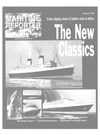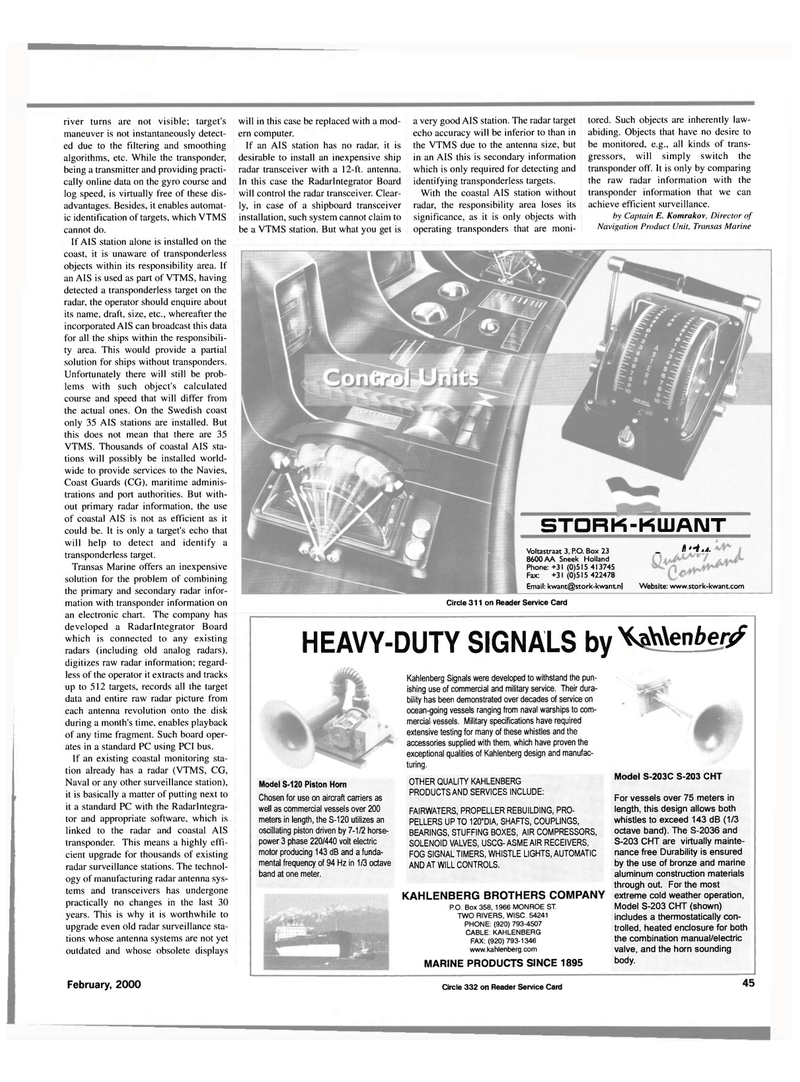
Page 45: of Maritime Reporter Magazine (February 2000)
Read this page in Pdf, Flash or Html5 edition of February 2000 Maritime Reporter Magazine
river turns are not visible; target's maneuver is not instantaneously detect- ed due to the filtering and smoothing algorithms, etc. While the transponder, being a transmitter and providing practi- cally online data on the gyro course and log speed, is virtually free of these dis- advantages. Besides, it enables automat- ic identification of targets, which VTMS cannot do.
If A1S station alone is installed on the coast, it is unaware of transponderless objects within its responsibility area. If an AIS is used as part of VTMS, having detected a transponderless target on the radar, the operator should enquire about its name, draft, size, etc., whereafter the incorporated AIS can broadcast this data for all the ships within the responsibili- ty area. This would provide a partial solution for ships without transponders.
Unfortunately there will still be prob- lems with such object's calculated course and speed that will differ from the actual ones. On the Swedish coast only 35 AIS stations are installed. But this does not mean that there are 35
VTMS. Thousands of coastal AIS sta- tions will possibly be installed world- wide to provide services to the Navies,
Coast Guards (CG), maritime adminis- trations and port authorities. But with- out primary radar information, the use of coastal AIS is not as efficient as it could be. It is only a target's echo that will help to detect and identify a transponderless target.
Transas Marine offers an inexpensive solution for the problem of combining the primary and secondary radar infor- mation with transponder information on an electronic chart. The company has developed a Radarlntegrator Board which is connected to any existing radars (including old analog radars), digitizes raw radar information; regard- less of the operator it extracts and tracks up to 512 targets, records all the target data and entire raw radar picture from each antenna revolution onto the disk during a month's time, enables playback of any time fragment. Such board oper- ates in a standard PC using PCI bus.
If an existing coastal monitoring sta- tion already has a radar (VTMS, CG,
Naval or any other surveillance station), it is basically a matter of putting next to it a standard PC with the Radarlntegra- tor and appropriate software, which is linked to the radar and coastal AIS transponder. This means a highly effi- cient upgrade for thousands of existing radar surveillance stations. The technol- ogy of manufacturing radar antenna sys- tems and transceivers has undergone practically no changes in the last 30 years. This is why it is worthwhile to upgrade even old radar surveillance sta- tions whose antenna systems are not yet outdated and whose obsolete displays
HEAVY-DUTY SIGNALS by berf will in this case be replaced with a mod- ern computer.
If an AIS station has no radar, it is desirable to install an inexpensive ship radar transceiver with a 12-ft. antenna.
In this case the Radarlntegrator Board will control the radar transceiver. Clear- ly, in case of a shipboard transceiver installation, such system cannot claim to be a VTMS station. But what you get is a very good AIS station. The radar target echo accuracy will be inferior to than in the VTMS due to the antenna size, but in an AIS this is secondary information which is only required for detecting and identifying transponderless targets.
With the coastal AIS station without radar, the responsibility area loses its significance, as it is only objects with operating transponders that are moni- tored. Such objects are inherently law- abiding. Objects that have no desire to be monitored, e.g., all kinds of trans- gressors, will simply switch the transponder off. It is only by comparing the raw radar information with the transponder information that we can achieve efficient surveillance. by Captain E. Komrakov, Director of
Navigation Product Unit, Transas Marine
Circle 311 on Reader Service Card
Kahlenberg Signals were developed to withstand the pun- ishing use of commercial and military service. Their dura- bility has been demonstrated over decades of service on ocean-going vessels ranging from naval warships to com- mercial vessels. Military specifications have required extensive testing for many of these whistles and the accessories supplied with them, which have proven the exceptional qualities of Kahlenberg design and manufac- turing.
OTHER QUALITY KAHLENBERG
PRODUCTS AND SERVICES INCLUDE:
FAIRWATERS, PROPELLER REBUILDING, PRO-
PELLERS UP TO 120"DIA, SHAFTS, COUPLINGS,
BEARINGS, STUFFING BOXES, AIR COMPRESSORS,
SOLENOID VALVES, USCG-ASME AIR RECEIVERS,
FOG SIGNAL TIMERS, WHISTLE LIGHTS, AUTOMATIC
AND AT WILL CONTROLS.
KAHLENBERG BROTHERS COMPANY
P.O. Box 358, 1966 MONROE ST.
TWO RIVERS, WISC. 54241
PHONE: (920) 793-4507
CABLE: KAHLENBERG
FAX: (920) 793-1346 www.kahlenberg.com
MARINE PRODUCTS SINCE 1895
Model S-203C S-203 CHT
For vessels over 75 meters in length, this design allows both whistles to exceed 143 dB (1/3 octave band). The S-2036 and
S-203 CHT are virtually mainte- nance free Durability is ensured by the use of bronze and marine aluminum construction materials through out. For the most extreme cold weather operation,
Model S-203 CHT (shown) includes a thermostatically con- trolled, heated enclosure for both the combination manual/electric valve, and the horn sounding body.
Model S-120 Piston Horn
Chosen for use on aircraft carriers as well as commercial vessels over 200 meters in length, the S-120 utilizes an oscillating piston driven by 7-1/2 horse- power 3 phase 220/440 volt electric motor producing 143 dB and a funda- mental frequency of 94 Hz in 1/3 octave band at one meter.
STORK-Kill AIMT
Voltastraat 3, P.O. Box 23 A "t.J. 8600 AA Sneek Holland
Phone: +31 (0)515 413745
Fax: +31(0)515 422478
Email: [email protected] Website: www.stork-kwant.com
February, 2000 Circle 332 on Reader Service Card 45

 44
44

 46
46
